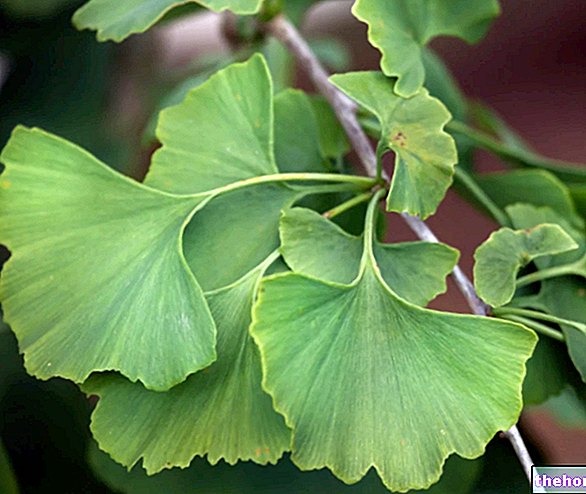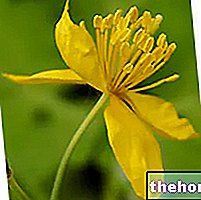Definition of Blue Algae
Among the prokaryotic and autotrophic unicellular bacteria, the blue algae stand out, known more commonly as cyanobacteria and scientifically as Cyanobacteria, Cianofita, Myxoficee, Schizoficee or, again, Cianoficee. [adapted from Reasoned dictionary of herbal medicine and phytotherapy, by A. Bruni]

General description
The blue (or green-blue) algae are commonly called such to recall their color, rendered by the phycocyanin, greenish or bluish pigment that perfectly camouflages the bright green color of chlorophyll; in addition to these pigments, it is possible to detect allophycocyanins and phycoherethrins in cyanobacteria, responsible, respectively, for the blue and red shades of the algae in question. Again, among the other pigments that can be found, there are: zeaxanthin, β-carotene, myxoxanthophyll and echinone. [taken from http://it.wikipedia.org/]
The blue algae represent the most ancient life forms ever, dating back to the Precambrian period (corresponding to over 3 billion years ago): it is believed probable that the blue algae have conquered the primacy of being the very first colonizers of the Earth, in able to produce its own nutrition thanks to photosynthesis. Studies carried out on fossils have brought to light important considerations: comparing the fossils of ancient bacteria with others of blue algae (eg Ainimikiea) their particular similarity was observed. [adapted from Plants. Origin and evolution , by A. Garassino]
The blue algae have some fundamental peculiarities:
- The cyanophycin granules constitute the reserve substance: it is a compound characterized by aspartic acid (or asparagine) and arginine, two amino acids present in equal quantities.
- The blue algae, in symbiosis with the fungi, form lichens
- The blue algae fix the atmospheric nitrogen in the heterocysts, special cells used not only for nitrogen fixing, but also for the conversion of elemental nitrogen into ammonia.
[adapted from Food plant botany, by C. Rinallo]
Botanical analysis
More than 2,000 species of blue algae have currently been identified, classified into 5 major systems according to their morphological structure. In any case, some authors do not approve the classification of algal species, as often happens, moreover, for many systematics of prokaryotic organisms.
We have seen that blue algae are prokaryotic (nucleusless) immobile unicellular microorganisms. Blue algae have a gram-negative cell wall. They live as single cells but, more often, they group together forming real cell colonies of aggregation; tant "is that the blue algae can organize themselves in branched, unbranched filamentous structures or in cenobia (small permanent or temporary colonies).
The blue algae have a thylakoid membrane, in which photosynthesis takes place.
As for the red algae, the blue ones also contribute to the formation of carbonate platforms: thanks to photosynthesis, they remove carbon dioxide from the atmosphere, favoring the precipitation of calcium bicarbonate (CaCO3).
As reserve substances, in addition to the aforementioned cyanophycin, there are also traces of polyphosphates (phosphorus reserve, known as volutin granules) and higher quantities of starch.
All varieties of blue algae are capable of producing cyanotoxins (whose name derives from cyanobacteria): these are toxins useful to the algae themselves as a defense from other unicellular algae, protozoa or potentially dangerous microorganisms.
Sometimes, the ingestion of some toxins - undermined in fish or molluscs - could give a fatal outcome to man (eg. BMMA toxin, produced by blue algae belonging to the genus Nostoc).
Blue algae: replication
Blue algae are ubiquitous aquatic organisms: they are found in thermal or cold waters, and in sweet or salty ones. Among the particularly favorable elements for the replication of blue algae are the alkalinity of the water and the high temperatures.
Being prokaryotes, blue algae have asexual reproduction by splitting.
Employments
Some species of cyanobacteria (eg. Arthrospira platensis, Arthrospira maxima Kütz, etc.) are grown for phytotherapeutic purposes: after cultivation and freeze-drying, blue algae can be used for the formulation of supplements, as some species represent a protein mine. Arthrospira platensis, in particular, it is also exploited for its richness in mineral salts, vitamins and gamma-linolenic acid (essential fatty acid); this algal species also contains a modest amount of vitamin B12, which is not used in phytotherapy since it is found in a non-bioavailable form.
Starting from some recent hypotheses formulated by the scientific community, it seems that the blue alga Arthrospira platensis (which together with the Arthrospira maxima it is found in supplements generically known as "spirulina") has potential antioxidant, immunostimulating and antitumor properties: in any case, further confirmations will have to be awaited to demonstrate the theory. The same goes for Aphanizomenon flos-aquae extracted from upper Klamath lake.
Summary
- Phycocyanin: greenish or bluish pigment that perfectly camouflages the bright green color of chlorophyll
- Allophycocyanins responsible for the blue shades
- Phycoerethrins responsible for red shades
- Other pigments: zeaxanthin, β-carotene, myxoxanthophyll and echinone
- Most ancient life forms ever, dating back to the Precambrian period
- The very first colonizers of the Earth, able to produce their own nourishment thanks to photosynthesis
- Particular similarity between ancient bacteria and blue algae (eg. Ainimikiea)
- 2,000 species of blue algae, classified into 5 major systems
- Prokaryotic immovable unicellular microorganisms (without nucleus)
- Gram-negative cell wall
- They live as single cells but, more often, they group together forming real cell colonies of aggregation
- Organization in branched, unbranched filamentous structures or in cenobia
- Thylacoid membrane, in which photosynthesis takes place
- They contribute to the formation of carbonate platforms
- Reserve substance: cyanophycin, polyphosphates (phosphorus reserve, known as volutin granules), starch
- Toxins: cyanotoxins (defense from other unicellular algae, protozoa or from potentially dangerous microorganisms)
- Ubiquitous aquatic organisms (thermal or cold waters, fresh or salt waters)
- Particularly favorable elements for replication: alkalinity of water and high temperatures
- Reproduction: asexual by splitting
cultivation → freeze drying → formulation of protein supplements
Arthrospira platensis: blue alga also exploited for its richness in mineral salts, vitamins and gamma-linolenic acid, to which potential antioxidant, immunostimulating and anticancer properties are ascribed
Select plant Fir Acacia Acerola Sorrel Yarrow Yarrow Yarrow Aconito Adatoda Garlic Agnocasto Agrimonia Alchemilla Alkekengi Aloe Altea Witch Hazel Ammi or Visnaga Pineapple Andrographis Anemone Pulsatilla Angelica Anise Star Anise Japanese Star Anise Bitter Orange Bitter Areca Arnica Harpagophytum Arpagophyte Artemisia Asteragus Basil Asparagus Asparagus Peruvian Asparagus Asparagus Asparagus Hawthorn Boldo Borage Shepherd's Purse Boswellia Bucco Butea superba Cocoa Coffee Cajeput Calamus Calamus Marigold Camedrio Chamomile Roman Chamomile Camphor Cinnamon Ceylon Maidenhair Capuchin Artichoke Cardamom Cardiac Thistle Asian Thistle Carvi Cascara Cassia Catecu Catha Cabbage Celandine Chicory Centaurea Cinnamon Cypress Celandine Chives Cypress Coca Cola Colchico Combreto Condurango Comfrey Coriander Cranberry Barberry American Chrysanthemum Cumin Turmeric Damiana Digital Dioscorea Drosera Dulcamara Dunalilella Echinacea Eder a Ephedra Elenio Eleutherococcus Helichrysum Evening primrose Horsetail Alfalfa Erica Euphrasia Erisimo Escolzia Eucalyptus Farfara Farfaraccio Calabar bean Fenugreek Fennel Phytolacca Frangola Ash Fumaria Japanese Mushrooms Galega Ganoderma lucidum Garcinia Cambogia Mulberry Gentian Broom Ginkgo Ginkgo Guipana Guipana Gynestra Ginkgo Hibelia Gymnasium Hibiscus Guarulp St. John's Wort Horse Chestnut Ispaghul Hyssop Jaborandi Kava kava Konjac Laminaria Cherry Laurel Lavender Lemongrass Lespedeza Lovage Icelandic Lichen Lemon Flax Lippia Licorice Lobelia Hops Maca Marjoram Maize Mallow Manna Marrubio Marrubio d "water Matè Melaleuca Meliloto American Lemon balm Myrtle Myrama Walnut Nutmeg Walnut vomica Olive tree Meadowsweet Ononide Opuntia Oregano Orthosiphon Nettle Poppy Papaya Parietaria Feverfew Passiflora Chilli Perilla Periwinkle Phyllanthus Plantain Picrorhiza Pilosella Pino Pisci dia Podofillo Polygala Grapefruit Parsley Psyllium Pueraria mirifica Butcher's broom Pygeum Quassia Oak Rhubarb Ratania Rauwolfia currant Castor bean Rhodiola Rosehip Rosemary Rue Willow Sarsaparilla Sage Elderberry Sassafras Sedum Ergot Senna Serenoa Repens Soybean Solidago Tansy Taraxus Tamarind Tamarind Tamarind Tamarind Tamarindo Ursina Valerian Vanilla Mullein Verbena Veronica Viburnum Vinca Pansy Mistletoe Vine Withania Yohimbe Saffron Ginger Pumpkin Select disease Juvenile Acne Rosacea Tinnitus Tinnitus Aerophagia Tendon Affections Afonia Aphthae Algias Functional Halitosis Breastfeeding Allergy Anemia Anguish Anxiety Arteriosclerosis Asthrosis Asthrosis Arthritis Arthritis Men Sex Woman Blepharitis and Conjunctivitis Eye bags Bronchitis Gallstones Kidney stones Salivary stones Baldness Androgenetic Candida Fragile hair Caries Headache Cellulitis Motion sickness Cystitis C limaterio Cholecystopathy High cholesterol Ulcerative colitis Colonoscopy Contusions Hematoma Convalescence Couperose Depression Dermatitis Diaper dermatitis Diabetes Diarrhea Erectile dysfunction Dyslipidemia Dysmenorrhea Dyspepsia Disturbances of vision Hemorrhoids Epistaxis Herethism Heart disease Fever Fibromyalgia Gastro-intestinal disease Flatulence Hypertension Fibromyalgia Gastrointomnia Jaundice Laryngitis Renal lithiasis Toothache Sore throat Thinness Menopause Meteorism Mononucleosis Alzheimer's disease Crohn's disease Nausea Vomiting Obesity Dark circles Onychomycosis Osteoporosis Dry skin Periarthritis Piorea Low pressure Prostatitis Psoriasis Colds Breast fissures Anal fissures Gastro-nasal rhinitis Senescence Premenstrual Syndrome Sinusitis Quit smoking Overweight Fatty liver Constipation Stomatitis Stress Cough Triglycerides high Ulcer Burns Nails Brittle flashes Heat Warts Dizziness Properties herbal Tanning Abortive adaptogenic Aphrodisiac bittering analgesic anesthetic anorectics analgesic antacid anti-allergic anti-asthmatic Antibiotic catarrh Anticellulitiche anticonvulsant Antidiaforetiche antidiarrheal edematous anthelmintic antiemetic Antiemorroidarie antiphlogistic Antiidrotiche Antinevrotiche Antioxidants antipyretic antirheumatic antiscorbutic Antiseptic antispasmodic anti-uric Aperitive Flavoring Astringent Balsamic Bechiche Capillarotrope Cardiotonic Carminative Cathartic Caustics Healing Cholagogues Choleretic Dyes Decongestants Deodorants Purifying Diaphoretic Cleansers Disinfectants Detoxifiers Thirst quenching Diuretics Exciting Emetics Emmenagogues Emollients Hemostatic Energies Hepatoprotectors Expectorants Eupepticus Moisturisers Galactosensitizers lanti Hypertensive Hypnotic Hypoglycemic Hypotensive Irritants Laxatives Soothing Narcotic Nerves Nutrients Odontalgic Pectoral Purgative Revulsive Remineralizing Refreshing Rubefacient Scialagoghe Sedative Soporifugas Sneezing Stomachic Stomatics Narcotic Vascular Tightenitis























-nelle-carni-di-maiale.jpg)




